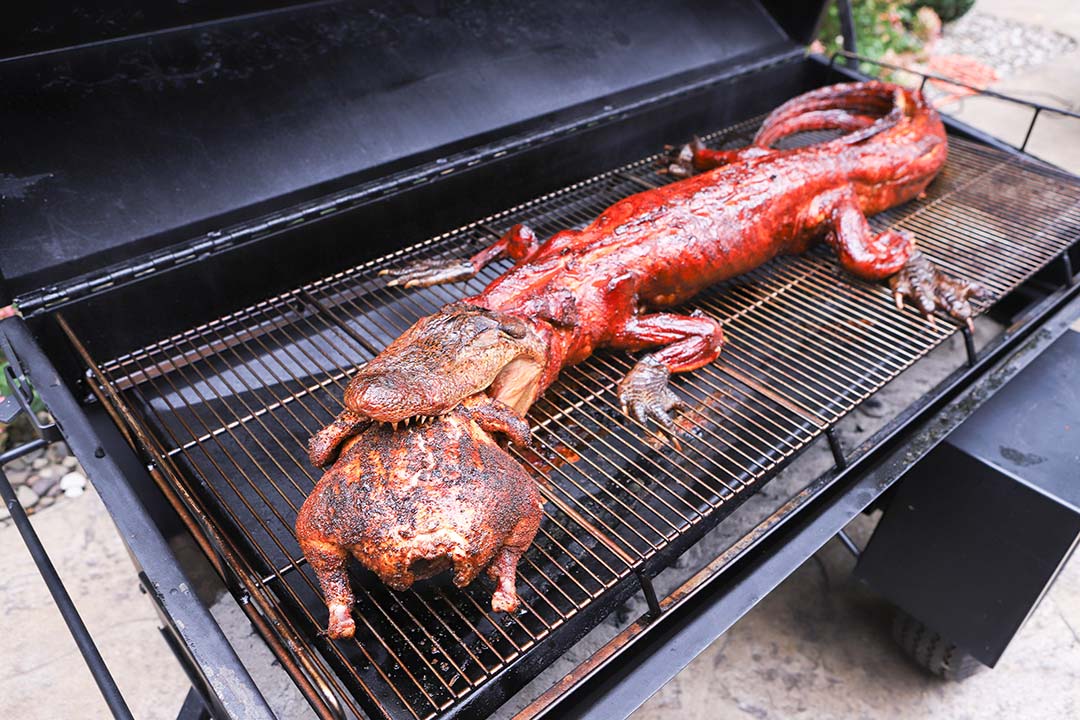Whole Smoked Alligator with Cajun Glaze
JoyOuceKitchen Picture from Meadow Creek Publisher
Picture from Meadow Creek Publisher
This whole smoked alligator with Cajun glaze isn't just a meal, it's a prehistoric adventure for your taste buds. Brined for tender perfection, the gator is then cloaked in a fiery Cajun rub, its crevices filled with smoky heat. After a slow smoke bath, the mahogany skin tightens, glistening with rendered fat. A final brush of deeply flavored Cajun glaze creates a glistening ruby exterior, a promise of smoky, savory flesh with a kick of Cajun heat.
| Prep Time | Brine Time | Cook Time |
| 30 mins | 24 hrs | 4 hrs |
INGREDIENTS
- 30 lb whole dressed alligator (ensure it's been professionally cleaned and butchered)
- 1/2 cup kosher salt
- 1/4 cup brown sugar
- 1/4 cup granulated sugar
- 1 tbsp black pepper
- 1 tbsp cayenne pepper (adjust for desired spice level)
- 1 tbsp paprika
- 1 tbsp garlic powder
- 1 tbsp onion powder
- 1 lemon, halved
- 1 orange, halved
- 1 yellow onion, quartered
- 2 bay leaves
- 1 gallon water
- Pecan wood chips
- Cooking twine (optional)
Cajun Glaze
- 1 cup ketchup
- 1/2 cup Worcestershire sauce
- 1/4 cup hot sauce (e.g., Tabasco)
- 1/4 cup brown sugar
- 2 tbsp Dijon mustard
- 1 tbsp white vinegar
- 1 tsp cayenne pepper
- 1/2 tsp black pepper
INSTRUCTIONS
step 1: BrineIn a large container (like a cooler) big enough to hold the alligator, dissolve the salt, brown sugar, and granulated sugar in the water. Add the black pepper, cayenne pepper, paprika, garlic powder, and onion powder. Stir well to combine.
step 2: Prep the GatorThoroughly rinse the alligator under cold running water. Pat it dry with paper towels. ⭐Safety Note: Alligator teeth can be sharp. Use caution while handling.
step 3: Citrus and Onion CavityStuff the gator's cavity with the lemon, orange, and onion quarters. Add the bay leaves.
step 4: BriningSubmerge the alligator completely in the brine. Tip: If the alligator floats, weigh it down with a plate or use cooking twine to tie its legs together. Cover the container and refrigerate for at least 12 hours, preferably 24 hours.
step 5: Smoker SetupPrepare your smoker for low and slow cooking, aiming for a temperature between 225°F and 275°F. Soak the pecan wood chips in water for at least 30 mins before adding them to the smoker.
step 6: Gator Prep for SmokingRemove the gator from the brine and pat it dry again. Discard the brine and cavity contents.
step 7: SeasoningCombine the remaining dry ingredients (black pepper, cayenne pepper, paprika, garlic powder, and onion powder) in a bowl. Sprinkle the seasoning mix generously all over the alligator, making sure to get into all the crevices.
Smoking Process:
step 8: Smoking the GatorCarefully place the seasoned gator on the smoker grate. Insert a meat thermometer probe into the thickest part of the tail muscle, not touching bone. Smoke the gator for 3-4 hours, maintaining the desired smoker temperature.
step 9: Monitoring Internal TemperatureUse the meat thermometer to monitor the internal temperature. The gator is done when the internal temperature in the thickest part of the tail muscle reaches 165°F.
step 10: Glazing (Optional)In the last hour of smoking, you can add a layer of flavor with a Cajun glaze. In a saucepan, combine all the Cajun Glaze ingredients and simmer for 10 mins. Brush the glaze liberally over the gator every 20-30 mins.
step 11: RestingOnce the gator reaches the desired internal temperature, remove it from the smoker and loosely cover it with foil. Let it rest for at least 1 hour to allow the juices to redistribute.
Carving and Serving:
step 12: CarvingCarefully transfer the gator to a large cutting board. Use a sharp knife and kitchen shears to remove the head and legs. ⭐Safety Note: Remember, alligator teeth are sharp! Be cautious while handling the head.
step 13: Separating the MeatThe backstrap meat and tenderloins in the tail are the most prized parts. Use a sharp knife to remove the backstrap meat along the spine. For the tail, locate the tenderloin muscles running alongside the bone and carefully remove them.
step 14: ServingThe remaining gator meat can be chopped or pulled for sandwiches, tacos, or served on its own with your favorite dipping sauces.
TIPS:
- Wear gloves while handling the raw alligator.
- The alligator's skin is not typically eaten. You can remove it before or after smoking, depending on your preference.
- You can adjust the amount of spices in the rub and glaze to your preference.
- Consider stuffing the cavity with aromatics like citrus slices, onions, or herbs before smoking for added flavor.
- Leftover smoked alligator can be stored in an airtight container in the refrigerator for up to 3 days or frozen for longer storage.
